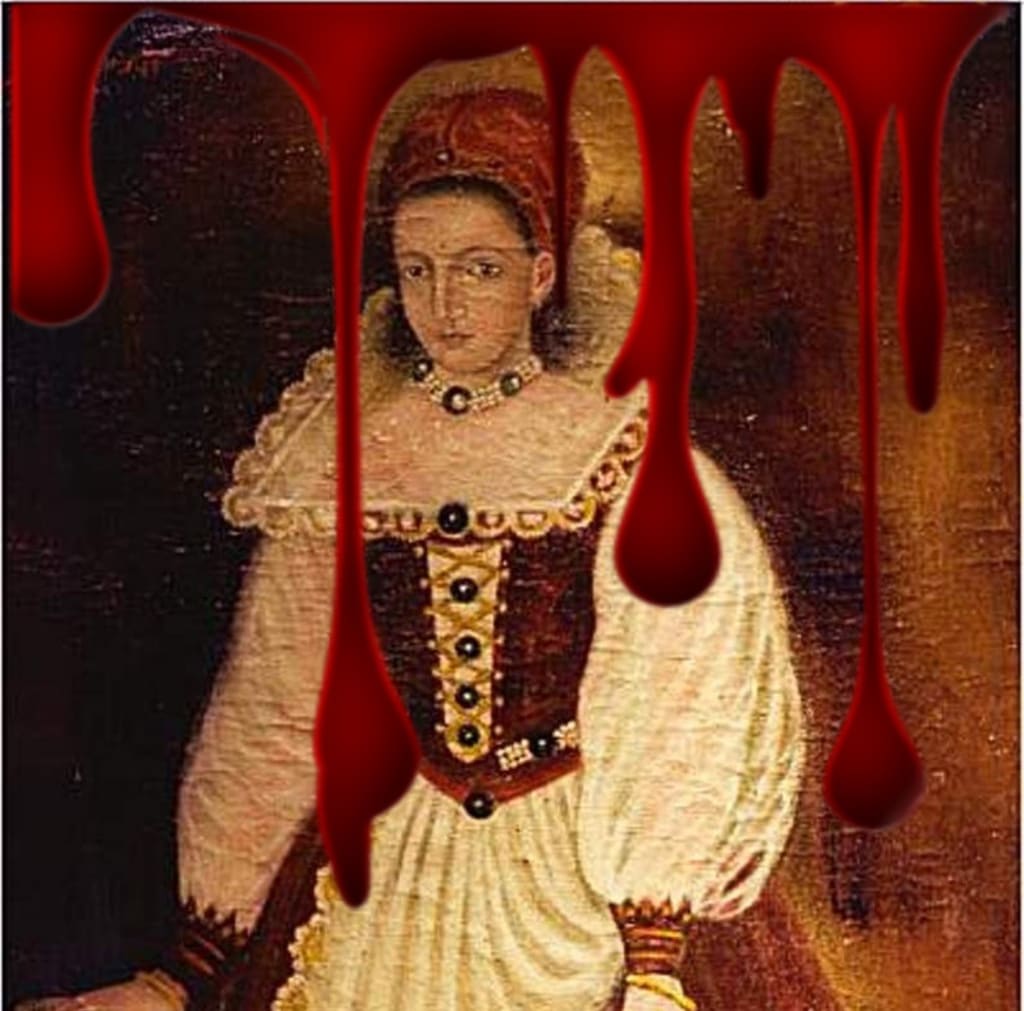Move over Vlad the Real Dracula was a Woman
The Story of the Erzsébet Báthory: The Blood Countess

(Trigger warning: While I do not go into graphic detail the following article deals with torture and vampiric tendencies)
* Author's note: So, I find that I need to start this article with a small apology. I have a bachelor’s degree in literature, and I have an interest in history. History tells the stories that came before us after all. I have this tendency to find a thread and pull and pull and pull as if it’s taffy. I find myself in one of those situations with this article. Yea, sorry about that. But come on Alice, we are heading down the rabbit hole.
Did you know that there was a woman in the 1500s that bathed in human blood, tortured people and killed hundreds of people? I didn't. I had never heard of Erzsébet Báthory and her crimes until I happened to read a fiction book that mentioned her. It caught my interest. Bathed in blood you say? Had a torture chamber? Hmmm... Maybe if I lived in Europe I may have known who she was. Certainly if I lived in Hungary or Romania the myth would have been well known. But being an American I had not heard of her until the mention of her in the book. Furthermore, the book implied that political and monetary troubles of the time may have led to the conspiracy against the countess. Could she be innocent? Not bloody likely. (see what I did there?)
My curiosity was peaked, I decided to do some research. I appealed to my old friend: google scholar. I found some very interesting information. First off, Erzsébet Báthory was a countess in the Kingdom of Hungary but that does not mean modern Hungary. An interesting fact is that the province of Transylvania was a part of the Kingdom of Hungary while the countess was alive and this province was linked to her family. Could this deranged serial killer have inspired Dracula? Wiki says that many think this is the case, but that it can't be proven. Yet, a noble woman who (possibly) drinks blood and bathes in the blood of virgins who is also tied to Transylvania... well I believe that her stories were at least part of his inspiration. Vlad Tepes (you might know him better as Vlad the Impaler) may have helped inspire Dracula but I bet that rumors of the blood countess sparked Stoker's imagination as well. The fact that the blood baths and blood drinking has never actually been substantiated is neither here nor there... rumors of her tendencies still exist to this day.
Many of the articles and books I encountered centered on Erzsébet Báthory's guilt and the idea that she was one of the first and worst serial killers. With over 600 (possible) victims she is even in the Guinness Book of World Records as, "The most prolific female murderer and the most prolific murderer of the western world, was Elizabeth Báthory, who practiced vampirism on girls and young women. " (Her name is often changed from Erzebet to Elizabeth). Erzsébet Báthory, also known as the Blood Countess (and various other gruesome names), is a mysterious figure and her story seems to be a mixture of myth and fact. Since she was born in 1560 and died in 1614 we may never truly know. However, she allegedly tortured and killed a vast number of peasant girls. The number at the trial against her 4 accomplices was 80, but there are testimonies that claim the number is as high as 650. She was said to have tied up servants and then she would cover them in honey so that ants and bugs would attack them. She was also known to torture these women in various ways from needles to fire. Furthermore, rumors of cannibalism and blood drinking swirl around this woman. That is why some call her the first vampire. The most chilling rumors were that she used to bathe in the blood of virgins to keep herself youthful… what girl doesn’t want a good skin care regime, right? (Not that I am recommending this one. Murdering people for skincare is bad.)

What is known about the eventual downfall of Erzsébet Báthory is that after many murders and much torture an investigation was launched. There was a trial and four of her accomplices were pronounced guilty and killed. Her wealth shielded her at least partially, Erzsébet Báthory was never tried but, she was imprisoned in a room in her own castle with a slit for food and water. She died 3 years after her incarceration. The story was buried with her death so that her family could save face. There were over 300 hundred witnesses against her, and many disappearances and death linked to her. Interestingly (and not surprisingly) she was only brought to justice because she began killing gentry (young noble women sent to her castle to learn etiquette)- when she was murdering and torturing peasants most people turned a blind eye. Shocker, right?
Being slightly obsessed with this subject now, I found out about a book called, The book THE BLOODY COUNTESS: Atrocities Of Erzsebet Bathory written by Valentine Penrose. I may have bought on kindle- Told you- rabbit hole. It is a chilling true-crime book that details the countesses vile practices. The book begins with, "This is the story of the Countess who bathed in the blood of girls. An authentic story, hitherto unpublished in its horrific entirety anywhere" (Penrose, intro). The book goes on to detail many atrocities, torture that will turn your hair white and a husband that was amused by her "antics" rather than repulsed by them. Furthermore, the book speaks about her dabbling in witchcraft and Satanism, claiming that her close friend taught her to be a witch and that their were relatives in her family that were Satanists. She offers what documents are left after so many years and gives as much information about the trial as is possible. In Penrose's book there is no question that she believes the countess was a historical figure that was indeed a serial killer with blood on her hands...

But was she a deranged serial killer, or was she framed? Uh oh- the plot thickens.
No one wrote about the countess until a century after her death and thus her story was lost to history for a long time. Eventually, scholars began to wonder if the tale was actually true. Many books surfaced with arguments against the “myth” of Erzsébet Báthory as a vampire or vile torture. There are several main arguments that people use to fight the narrative of the Blood Countess. One, King Mathias II was the one who ordered her investigated. This is suspicious because the crown owed money to the countess. Imprisoning someone that you owe money to is one way to negate a debt. Also, he was having trouble (rebellion kind of trouble) with the king of Poland who happened to be Erzsébet Báthory’s brother. Some historians have suggested that the king was particularly interested in Erzsébet because of these political troubles. The next piece of evidence for her innocence is that she was a powerful strong-willed woman who was also a widow. In English literature and Gothic lit. I learned that the widow was one of the best states for a woman to be in as far as being in charge of herself and her possessions is concerned. Married woman essentially belong to their husbands. To be a noblewoman and a widow gives a woman a certain amount of power. Countess Bathory had agency that most women did not possess. The final piece of evidence that points to the countess being the target of a conspiracy is the information about her trial, or rather the trial of her accomplices. Her four accomplices were tortured which makes their testimony suspect. All these things combined seem to suggest that Countess Báthory was framed and she was not, in fact, a serial killer after all.
However, most of the scholars that take up this fight don’t take all this evidence together, which suggests that not all of it is verifiable. This is not surprising since the woman died over 500 years ago. But why not put the nail in the coffin if it was so simple? I stumbled upon this thesis dissertation: "No Blood in the Water: The Legal and Gender Conspiracies Against Countess Elizabeth Bathory in Historical Context" by Rachael Leigh Bledsaw. (Full discloser I did not read the entire dissertation because it was almost 200 pages but I did skim through and I found some interesting things.) The author takes the various conspiracies that are laid at the feet of our bloody countess and examines the things that were written about these conspiracies. Bledsaw then discusses them in great detail expressing doubt over many of their arguments. To be clear, Rachael Bledsaw does not come out and say that Erzsébet Báthory is guilty, on the contrary the paper seems to leave the reader with an ambiguous conclusion. She does suggest that some of the writers that tried to clear Báthory's name did not support their books with enough evidence. Bledsaw argues against the books that exonerate the countess not because she is sure of Bathory’s innocence but because their arguments are unsubstantiated. Though that in self expresses an opinion.
First the author discusses the fact that Erzsébet Báthory was a widow and a powerful woman with allies that the king, King Mathias II, found inconvenient. As to gender, Bledsaw states, "Because women had more influence than previously believed, and because of the perception that Eastern Europe was more accepting of a woman of strong personality, it would have been very unlikely that King Matthias II and Palatine Thurzo were actually threatened by the Countess, even when she was a widow" (23). In her dissertation, she suggests that previous authors failed to take into account the differences in how women were treated between Eastern and Western Europe, suggesting that her being a strong-willed widow was less of a big deal than some scholars seemed to think. The second argument is that the king was in debt to the Báthory estate. With Erzsébet's husband now dead and her locked up, those debts would disappear. Bledsaw suggests that too much attention is paid to the fact that, " the debt made the crown politically interested in her downfall. An additional reason to seek out her downfall was her relation to Gabor Bathory, King of Poland," (11). This debt was accrued during a previous war and it was unlikely that the wealthy countess Bathory was in need of the money from the crown. While the king may have benefited by her being removed, she was not brought to trial and her family was able to save face. There may have been issues with the king of Poland, but as the Kingdom of Hungry was full of conflict at that time, it was unlikely that she was being targeted because of her brother. There seem to be simpler ways to remove political rivals than accusing them of torture and fabricating 300 witnesses… 300 that’s an awful lot of staging to screw over one woman. The argument was that her four accomplices, who supposedly brought her victims, were tortured for their testimony. However, this was not uncommon in the justice system of the time. Bledsaw explains, “The evidence from the trial and the procedures laid out by the Tripartitum all indicate that Thurzo acted well within his rights as palatine in regards to the investigation of the Countess, his raid on and arrest at Cjesthe, and the trial and execution of the four accomplices” (161). To be clear this includes the torture- people on trial who took torturing three times without confessing were cleared of charges. She continues with, “Claims by enthusiasts of Bathory that state otherwise have not properly taken into account the Early Modern European judicial system, or the place of torture within it” (Bledsaw, 162). While there are arguments to support the idea that the poor Countess Bathory was the victim of a conspiracy most of these arguments have holes in them. It would be nice to be able to put a bow on it and claim that she was wrongly accused, but I can’t. The arguments are too disjointed and the evidence against her is compelling but the veil of time obscures the facts…
That being said, it is clear that the real story of the Blood Countess is a big ole kerfuffle. Was she a misunderstood historical figure who was helpful and kind and got screwed? A women that got turned into a monster because of political machinations and money? Or was she a depraved serial killer who gleefully tortured people and bathed in their blood? Since my time machine is not working (flux capacitor is on the fritz) we will never know. But it does make one hell of a story!
See my list of sources below.

Works Cited
Bledsaw, Rachael L. "No blood in the water: The legal and gender conspiracies against Countess Elizabeth Bathory in historical context." Illinois State University, 2014.
Penrose, Valentine. The Bloody Countess, trans. Alexander Trocchi. London: Colder and Boyors, 1970, digital copy.
The Guinness book of World Records. www.guinnessworldrecords.com/world-records/most-prolific-female-murderer.
*I got a lot of the basic information from the Wikipedia and Britannica articles about the countess and some information about the Kingdom of Hungary as well.
About the Creator
Katie L. Oswald (BookDragon)
I am not a book worm, I am a book dragon. I love comics, books, photography and all things creative. I have always been drawn to the stories of life and have been writing for as long as I can remember. Twitter: @BookDragonklo






Comments
There are no comments for this story
Be the first to respond and start the conversation.